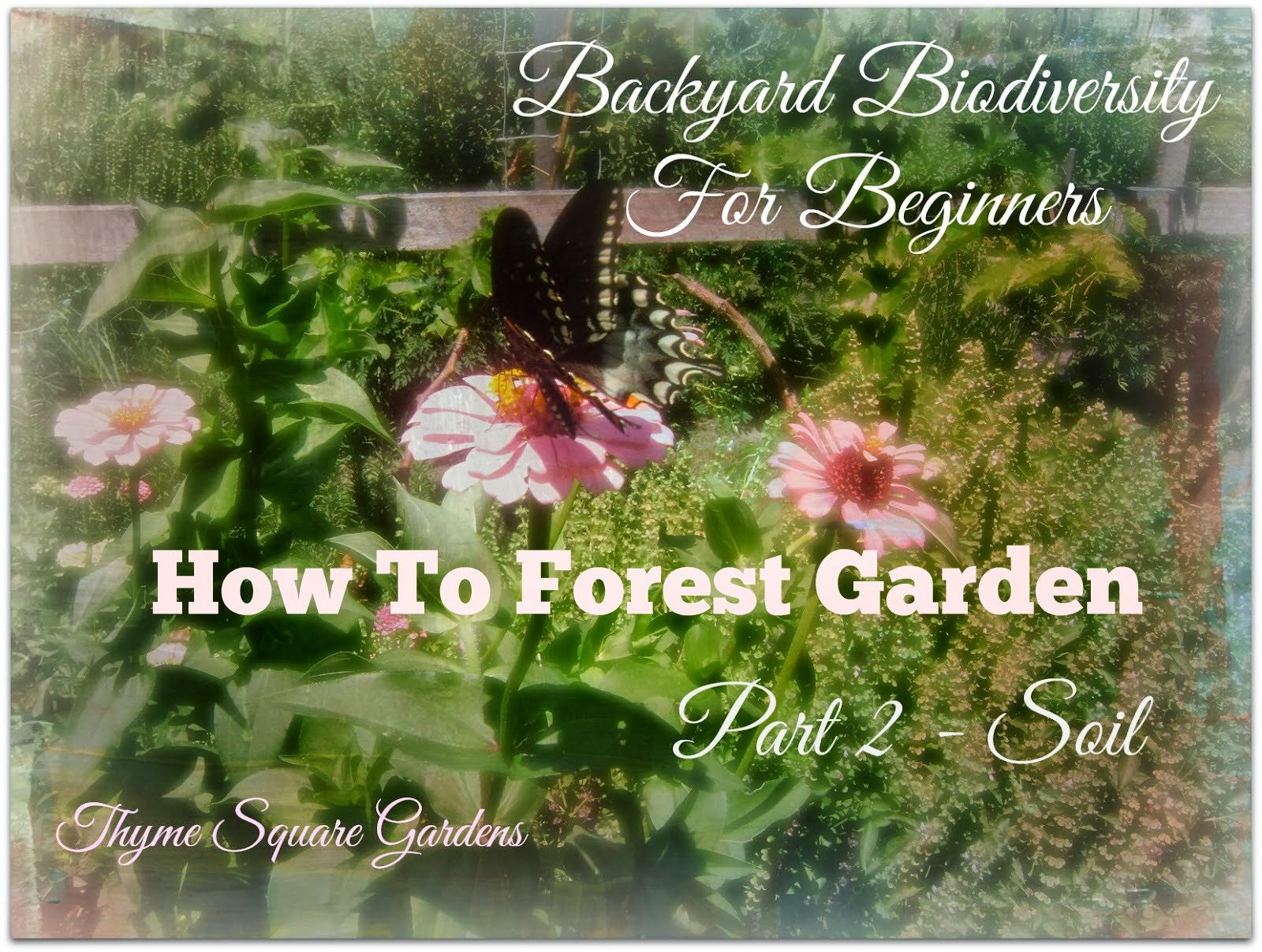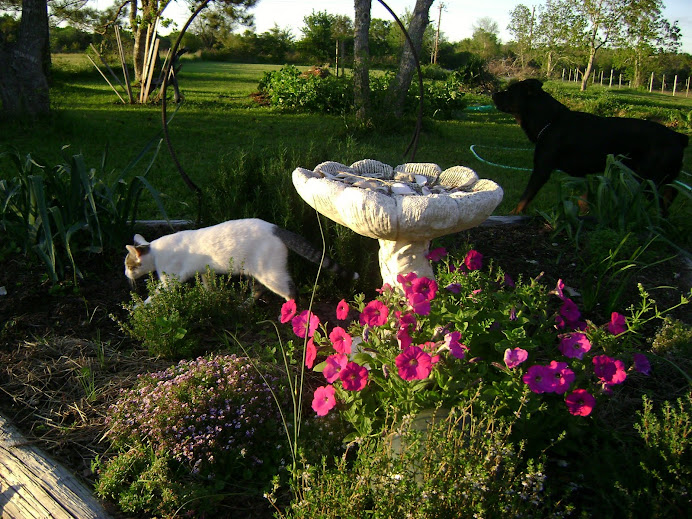The fluttering of a butterfly's wings can effect climate changes on the other side of the planet. ~ Paul Erlich
Beginning our quest in achieving backyard biodiversity was really a matter of simple science. I pondered on this a bit as my 3 yr. old grandson was asking me questions in the garden.
It's as simple as our 4 basic elements for growing a garden. The sun, the soil, the water and the seed.
Our first step will always be building the foundation. Which for the garden the foundation is the soil.
Our first step will always be building the foundation. Which for the garden the foundation is the soil.
You may have been using chemicals and want to change to living a more sustainable and healthy organic lifestyle. Or perhaps you may just be starting out on your first try at gardening.
We must begin with building a soil that is alive with living organisms.
We must begin with building a soil that is alive with living organisms.
Keep in mind that if you have been using chemicals and pesticides you will most likely be missing most of the vital elements in your soil.
Depending on the applications, traces of some chemicals can remain in your soil for years. You may consider having your soil tested before growing edible vegetation.
Depending on the applications, traces of some chemicals can remain in your soil for years. You may consider having your soil tested before growing edible vegetation.

We must begin somewhere and the easiest way to understand how to create diversity is to picture a natural forest. Since we are making healthy soil we will concentrate on the forest floor itself.
Depending on your area and what materials are available to you will determine what your forest floor will consist of. As you can see in our diagrams the trees provide most of the forest floor by falling leaves.
In the forest you have a natural canopy that provides all the nutrients for the soil.
Ideally we want to create a natural canopy in our backyards. It is always a good idea to plant native trees and shrubs that would naturally grow in your area. This natural canopy would not just provide you with rich organic soil that is teaming with life, but also a natural habitat for wildlife as well.
For your forest floor you need a whole lot of organic matter. Begin your compost pile. Rake leaves and gather grass clippings and pile it up. Save your produce kitchen scraps as well as eggshells, coffee and tea scraps and bury them in the pile.
I usually pour my kitchen scraps at the bottom of the pile and then rake down some leaves to cover it up.
Because the area in which I live is considered prairie, trees are scarce here. The original farms in this area grew large fields of watermelons which are very heavy feeders. Heavy feeding crops strip the soil of all its nutrients.
They can be replaced with organic matter when farmed properly. Growing cover crops and good rotation methods are basically what is called for.
They can be replaced with organic matter when farmed properly. Growing cover crops and good rotation methods are basically what is called for.
We have had a hard crusty sand at the surface and not far below that is clay. This is not so uncommon in Texas.
I would have to believe that this land was once rich in organic healthy soil since farmers found it very productive for farming their watermelons. They sure left it in very poor condition when they were finished.
I would have to believe that this land was once rich in organic healthy soil since farmers found it very productive for farming their watermelons. They sure left it in very poor condition when they were finished.
This is why it is such an urgent matter all over the planet to go back to good sustainable farming practices. We have to put back into the earth what we take out of it. Below is a simple diagram showing how nature would put nutrients back into the soil.

Since an abundance of organic matter was not available to me here, other than our own composting, I've had to get very creative.
We've had to grow many permaculture type plants to add more organic matter to our land.
We've had to grow many permaculture type plants to add more organic matter to our land.
Most people rake the leaves out of their flower beds and lawns, bag them up to be carried off to the land fill. Some burn them or have someone that picks them up and carries them away.
They find leaves to be such a nuisance, when the very thing they should be doing is leaving them in the flower beds instead of trying to replace them with some sterile mulch that seems rather pleasing to the eye for the perfect manicured landscape.
The leaves need to be composted and put back into the earth. In a healthy ecosystem like a natural forest, sterile would not provide the nutrients in which to feed itself. Without the organic matter you will have a hard time creating your backyard biodiversity without having to constantly add fertilizers and supplements to your landscape.
This can be done, but it is also very costly and time consuming. If needed to purchase it will be important to find a trusted source for organic materials.
`
If you take a deeper look into the edge of my cornfield, you will see the forest floor that we have created. You will most likely not find bare ground in any of the garden. Bare ground is what leads to pests and diseases.
If you were to rake back the leaves a bit you will find a healthy rich soil that is loaded with life. I've also created a canopy in the corn field. The corn is my tree reaching for the sky, while pole beans climb it's trunk for support and aiding in adding nitrogen back into the soil.
The pumpkins will climb through the forest floor seeking shelter from the hot sun as it finds shade under the corn. The pumpkins will also aid the corn as a living mulch to help retain moisture in the soil. This is the Native American system called Three Sisters.
Much can be learned from a people that were so close to earth and acknowledged how nature worked to provide for itself. In this little ecosystem of the Three Sisters will beneficial insects and micro organisms in the soil care for the health of the plants.
There will not be any need for chemicals or pesticides because the balance in nature takes care of itself. The materials for creating this small ecosystem cost nothing but the time and energy spent in raking and saving organic material and applying it in layers throughout the garden.
I believe when we quit trying to out smart nature and learn how perfect nature works all on its own we will soon be on the right track.
It never hurts to share with your neighbors to encourage them to have a healthy backyard. Greatly what our neighbors do will also reflect what happens in your own yard.
It never hurts to share with your neighbors to encourage them to have a healthy backyard. Greatly what our neighbors do will also reflect what happens in your own yard.
Happy Gardening!
Pammy




















.jpg)



















OMG Lizzie is beyond words adorable!!! Your pictures are fantastic. Thank you for taking the time to teach us! You certainly have inspired me...I even copied your raised beds!! Now I'm planting stuff I've never heard of to ward-off bugs in my garden. I do not go outside with a can of bug spray in my hand anymore! I have always leaned to the organic side, but you've made me a hard-core fanatic. I'm even talking to the bees...
ReplyDeleteThank You so much Ruth! Your raised beds are absolutely wonderful!! I have such a great feeling about this gardening season. My we have an abundant harvest to put up this year and many bees in which to converse with. May the earth be blessed for our grandchildren to enjoy and may they always remember how much we loved them ;)
ReplyDeleteI garden vicariously through you. Alas, my apartment has no room or the right sun for a proper garden.
ReplyDeleteTake good care,
Karen
LOL Karen. Hope you enjoy! We'll have to break out some recipes for you when I get caught up planting the garden. <3 xxooxx
ReplyDeleteEverything looks wonderful in that garden of yours, so you must be doing everything right with your soil and compost! Love the grandbaby pictures-what a sweetheart ;-)
ReplyDeleteHello Farm Lady, Thank You so much and so glad you stopped by! I think from your name and that gorgeous sunflower in your picture that you must be doing some growing as well ;) I look forward to hearing your garden adventures!!
ReplyDeletei have an over abundance of pine needles do you think that would work in lieu of leaves?
ReplyDeleteThere are several things that love the extra acid gained from using pine needles. Things like berries and tomato plants. I love using them for my strawberry plants ;)
DeleteHARD TO FIND PART 1
ReplyDeleteHARD TO FIND PART 1
ReplyDeleteOh I'm sorry Patty...let me check the links for you!!
DeleteHere is the link Patty http://thymesquaregarden.blogspot.com/2011/02/backyard-biodiversity-for-beginners.html
Delete